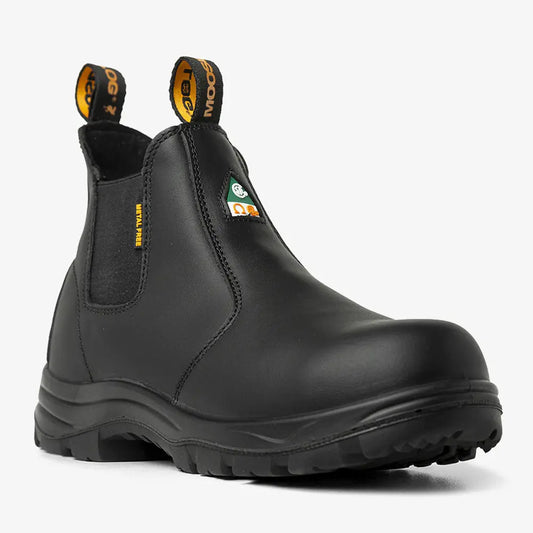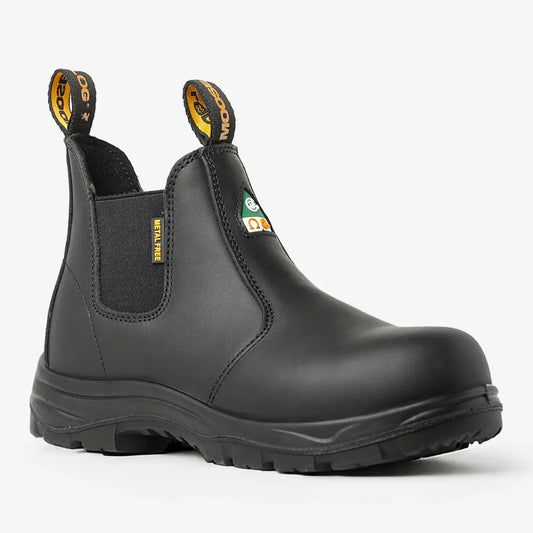
CSA Approved Safety Shoes: What You Need to Know
Workers across Canada rely on CSA approved safety shoes for protection in environments with impact hazards, sharp debris, and electrical risks. Safety footwear is part of every workplace safety program, and understanding the standards behind it helps you choose the right pair. This guide answers the most common questions workers ask about CSA approval, symbols, comfort, and toe protection.
What Are CSA Approved Safety Shoes?

CSA approved safety shoes are footwear that meet the safety requirements outlined in CSA Z195. This standard sets clear rules for impact protection, puncture resistance, electrical protection, static control, and metatarsal coverage. Every approved shoe carries a CSA symbol that shows the type of protection included.
Industries that commonly require CSA approved footwear include construction, transportation, warehousing, manufacturing, energy, utilities, and mining. Employers review the hazards on site and match those hazards with the correct CSA symbol. Many workplaces will only allow footwear that shows a visible CSA patch.
Workers in physically demanding jobs face hazards that can lead to foot injuries, including crushing, punctures, slips, and falls. The Canadian Centre for Occupational Health and Safety identifies these risks as common concerns across construction, warehousing, transportation, and manufacturing. CSA approved safety shoes help reduce these hazards when matched to the correct workplace requirements and symbols.
What Does “CSA Approved” Mean?
“CSA approved” means the footwear has passed laboratory testing that measures the strength of the toe cap, the ability of the sole to stop punctures, and the boot’s performance against electrical hazards, depending on which symbol applies. CSA does not test comfort, fit, or material quality. The approval focuses on safety performance only.
CSA Z195 includes clear test requirements such as:
- Toe impact resistance at a rated force
- Puncture resistance using a standard steel probe
- Electrical resistance tests for both conductive and electric shock resistant footwear
- Static control performance for sensitive work environments
Every CSA approved shoe will show a symbol such as a green triangle, yellow triangle, blue rectangle, white rectangle, or Omega symbol. These symbols follow the safety rules set by CSA Group under the Z195 standard.
What Is the Green Triangle on Safety Shoes?

The green triangle is one of the most common CSA symbols. It indicates:
- Grade 1 toe protection
- A puncture resistant plate in the sole
This combination suits job sites with nails, rebar, sharp metal, heavy loads, and equipment that can crush the toes. Construction workers, technicians, freight handlers, and heavy equipment operators often choose the green triangle because it covers multiple hazards in one rating.
Inventory counts, jobsite walkthroughs, and risk assessments often require workers to wear green triangle footwear before accessing restricted areas. The symbol provides a clear way for safety supervisors to confirm that workers are wearing the correct level of protection.
Do Safety Shoes Mean Steel Toe?
Safety shoes do not always mean steel toe. CSA allows several types of protective toe caps as long as they pass the impact and compression tests. These include:
- Composite toe
- Steel toe
- Alloy toe
- Nano composite toe
The choice depends on employer requirements, jobsite hazards, and personal preference. Composite toe caps have become more common in recent years in Canada because they reduce weight and do not conduct temperature or electricity. Steel toe remains widely used for consistency and familiarity across industrial environments.
The important detail is the CSA rating, not the toe material. If the symbol shows Grade 1 or Grade 2, the footwear has passed the required tests regardless of whether the toe cap is steel or composite.
Related Blog: Composite Toe vs Alloy Toe: A Simple Guide for Work Boot Buyers
How Do I Choose Comfortable Safety Shoes?

Comfort varies by brand, shape, foot type, and jobsite conditions. Many workers spend ten hours or more on their feet, so comfort affects productivity and long-term health. Here are factors that help when choosing comfortable safety shoes:
Fit: A snug heel, room for the toes, and a stable midfoot reduce strain during long shifts.
Weight: Lighter safety shoes reduce fatigue during walking and climbing.
Insoles: Supportive insoles help with standing on concrete or metal flooring.
Outsole grip: Slip resistant soles help on wet or dusty surfaces.
Breathability: Materials that allow airflow reduce heat and moisture.
Break-in time: Stiffer materials, especially full leather uppers, soften after several days of use.
Many workers spend ten hours or more on their feet, which makes comfort an important part of choosing safety shoes. A 2024 update from WorkSafeBC highlighted that poor fit and discomfort can affect a worker’s ability to wear protective equipment consistently. Workers benefit from shoes that fit well, support natural movement, and reduce strain during long shifts.
What’s the Best Safety Shoe Brand?
There is no single brand that fits every worker. Foot shape, jobsite hazards, weight preference, and material preference all influence the decision. A good safety shoe brand provides clear CSA symbols, reliable construction, durable materials, and consistent fit.
MooseLog produces CSA and ASTM certified footwear for Canadian workers who prefer footwear with composite protection, slip resistance, and tested safety components. MooseLog boots use the BigZone toe cap, the Dyna-Flex puncture plate, and the SafeTread outsole for dependable performance in environments with heavy impact and puncture risks. These features support long shifts and help workers stay protected without unnecessary bulk.
FAQ
Are employers required to provide safety shoes?
In Canada, employers must ensure workers have protective footwear when hazards are present. Some employers provide footwear, while others require workers to purchase their own. Policies vary by province and industry.
Are composite toe shoes CSA approved?
Composite toe shoes can be CSA approved if they pass the required impact and compression tests. The approval depends on the symbol, not the toe material.
Which CSA symbol offers the most protection?
The green triangle offers Grade 1 toe protection and a puncture resistant sole. This combination supports environments with multiple hazards.
Can I wear CSA approved safety shoes for indoor work?
Yes. Many indoor workplaces require protective footwear for inventory handling, warehouse operations, and maintenance.
Do all workplaces accept the same CSA symbol?
No. Employers choose symbols based on their hazard assessments. A warehouse may accept blue rectangle shoes, while a construction site may require the green triangle.




